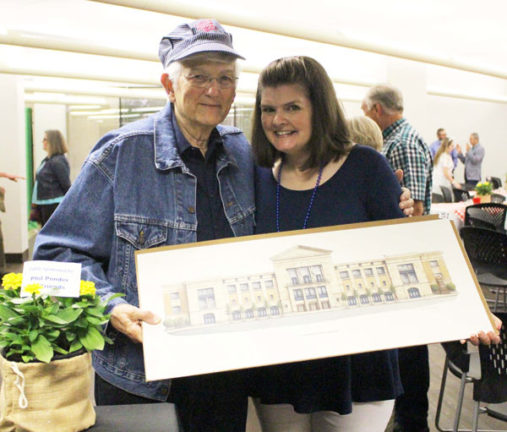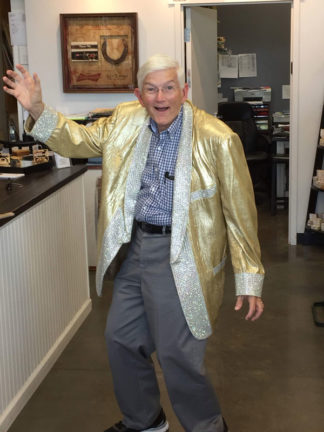Perhaps best known for his watercolor renderings of Nashville area skylines and historic buildings, Phil Ponder has captured our hearts and our Nashville for the last 50-plus years. He has been a part of Nashville’s landscape in a few ways: he served on Metro Council for four terms and later joined the staff of Congressman Jim Cooper. He credits council mentors including the late Vic Varallo and Judge Randy Kennedy for some of his early education. In this podcast Ponder shares snapshots of our yesterday including that building the new football stadium for Nashville’s first major league sports team was like “baptism of fire.” He also offers priceless tidbits about the letters on the first skyscraper in Nashville, the L&C Tower, as well as the priceless superhero unveiling of the architectural plans for the iconic “Batman” building in downtown Nashville.
As a dedicated family man, former Navy minesweeper (now fighting a personal battle against cancer), and a lover of peach milkshakes, learn how Ponder has redefined retirement, and how he keeps calm and carries on. Don’t miss this interview and these priceless Nashville nuggets.
Q. Will you tell us about your retirement transition?
A. It seems like I’ve been in about six different careers honestly, but I think the one you’re referring to is the fact that I was on staff for Congressman Jim Cooper for a little over 10 years. That was a great experience, and I really appreciate the fact that after my eight years of service in the Metro Council, other congressmen felt like I could lend a little bit of expertise to his staff in the area of community contacts, so that’s why I was placed on the staff.

Q. Did you work also in more of a corporate setting?
A. My main purpose in life for the earlier part of my life was to find a business that I was comfortable in, and that happened to work out to be the shoe business. When I was in high school, I worked on Saturday at a little shoe store in my hometown in Ocala, Florida. And we sold mostly products that were made by what was then General Shoe Corporation, which was later changed to Genesco… I had a lot of different responsibilities, everything from customer service … to being the president of two or three other divisions.
So that all ended in [19]89, and that’s when I had the opportunity to take my hobby, which was artwork.
I had seen a picture on the wall at Genesco of a little village in Italy called San Gimignano and the picture was just the city itself, the wall that surrounded the city with the watchtowers, and the church tower sticking above it. It really created an impression on me because it had no sky, and no land underneath the wall. So, I used that same concept on Market Street, which is now second avenue. There are 20 continuous buildings on that street.
In the interview Ponder credits the late Clara Hieronymus at “The Tennessean” for pushing his artwork to a new level when (in 1989) she featured the Market Street image in the Sunday newspaper. From that point forward his artwork really took off.

Q. Did you ever think that you might serve or have become Nashville’s visual historian?
A. Not initially. It just started out with Market Street, a picture, and that was… Of course, it contained a lot of history. Those buildings were built in the 1800s, and then I went on to other historic buildings, Union Station, the Hermitage, Parthenon, etcetera. And people started calling me a historian and I said, “Oh, I’ll accept that.” I was not really creating art so much; I was creating memories.
Q. What led you also to be a Metro Council member?
A. Actually, I have this personal code that a service to humanity is the best work of life. And so my way of service was to be in community organizations that help other people. And that’s really what led me to be in city council.
 Q. What is your definition of civic leadership, and what our responsibility you think is to engage or guide elected officials today?
Q. What is your definition of civic leadership, and what our responsibility you think is to engage or guide elected officials today?
A. My approach to this is that the community is good to me, so I should pay back the community through my talents and sometimes through money. So, it’s a return to the area that you live in, using your blessings to help other people out, and to… In the long run, improve the community itself.
Q. Will you tell us a bit more about your upcoming book?
And I’m just very blessed that I’m still here to do that. And, also, we’re doing a new skyline. And by the way, that’s one thing… Since I’ve done 11 skylines that are 14 by 30 inch in size, they represent an important change in history of downtown Nashville. So, because they’re from different views and of course about every four years is when I do it. There are new buildings that have come online. If you check back over those 11 skylines, you will be able to get a very good history of what happened to downtown Nashville.
Q. Is there anything else in your [creative] wheelhouse that we need to know about?
A: I have a special little garden. When our four kids were growing up I had maybe 45 different kinds of vegetables in that garden during the summer. And it still lingers on with me. I was in Future Farmers when I was in high school. So that kind of gave me a little bit of appreciation for the dirt. I still have this little garden in the back of where we live now, and it’s not real big, but this year it’s been a joy for me to go out there every day to look and see what’s blooming, and see the hummingbirds come in to attack the flowers. So it’s just been a great second joy for me on a daily basis.
Tune in for more Nashville trivia including the special weather-sensitive letters on the L&C Tower, as well as the “superhero” architect who presented the initial design for the infamous Batman building. Ponder also speaks about longevity and his mother who lived to be 112. His quest to give back to the community, stay active and engaged to Squeeze the Day is inspiring and worth sharing.


